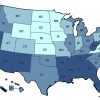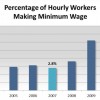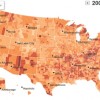Background

Spencer Grant / Getty Images
Low income and homeless people line up at a Barstow, CA, homeless shelter for free Christmas food distribution.
This page is no longer being updated. For ongoing coverage of this topic, go to Boise State Public Radio’s website.
Idaho’s poverty rate continued its upward climb in 2011, rising to 16.5 percent. That’s higher than the national rate of people living in poverty, which grew to 15.9 percent last year.
Put another way, more than 255,000 Idahoans lived below the federal poverty guideline last year.
The state’s poverty rate has climbed each year since 2007, when 12.1 percent of state residents lived below the poverty line. While the rate grew by 1.4 percent from 2008 to 2009 and again from 2009 to 2010, it grew by less than a percentage point from 2010 to 2011.
Source: U.S. Census Bureau
 In 2011, the federal poverty guideline was $22,350 for a family of four. Last year, 7 percent of Idahoans had incomes that amounted to less than 50 percent of the poverty line, according to a Census Bureau report.
In 2011, the federal poverty guideline was $22,350 for a family of four. Last year, 7 percent of Idahoans had incomes that amounted to less than 50 percent of the poverty line, according to a Census Bureau report.
The only neighboring state with a higher percentage of people living below the poverty line is Oregon, with a rate of 17.5 percent.
The annual poverty estimates are based on a combination of data from the American Community Survey, federal tax information, records on food assistance participation, Census statistics and annual population estimates.
How is Poverty Measured?
The Census Bureau uses a set of money income thresholds that vary by family size and composition to determine who is in poverty. If a family’s total income is less than the family’s threshold, then that family and every individual in it is considered in poverty. The official poverty thresholds do not vary geographically, but they are updated for inflation using Consumer Price Index (CPI-U). The official poverty definition uses money income before taxes and does not include capital gains or noncash benefits (such as public housing, Medicaid, and food stamps). – U.S. Census Bureau
Income Used to Compute Poverty Status:
- Includes earnings, unemployment compensation, workers’ compensation, Social Security, Supplemental Security Income, public assistance, veterans’ payments, survivor benefits, pension or retirement income, interest, dividends, rents, royalties, income from estates, trusts, educational assistance, alimony, child support, assistance from outside the household, and other miscellaneous sources.
- Non-cash benefits like food stamps or housing subsidies do not count.
- Before taxes
- Excludes capital gains or losses.
- If a person lives with a family, add up the income of all family members. Non-relatives do not count.
Measure of Need:
Poverty thresholds are the dollar amounts used to determine poverty status. Each person or family is assigned one out of 48 possible poverty thresholds.
Thresholds vary according to:
- Size of the family
- Ages of the members
If the total family income is less than the threshold, the family is in poverty. If total family income equals or is greater than the threshold, the family is not in poverty.








